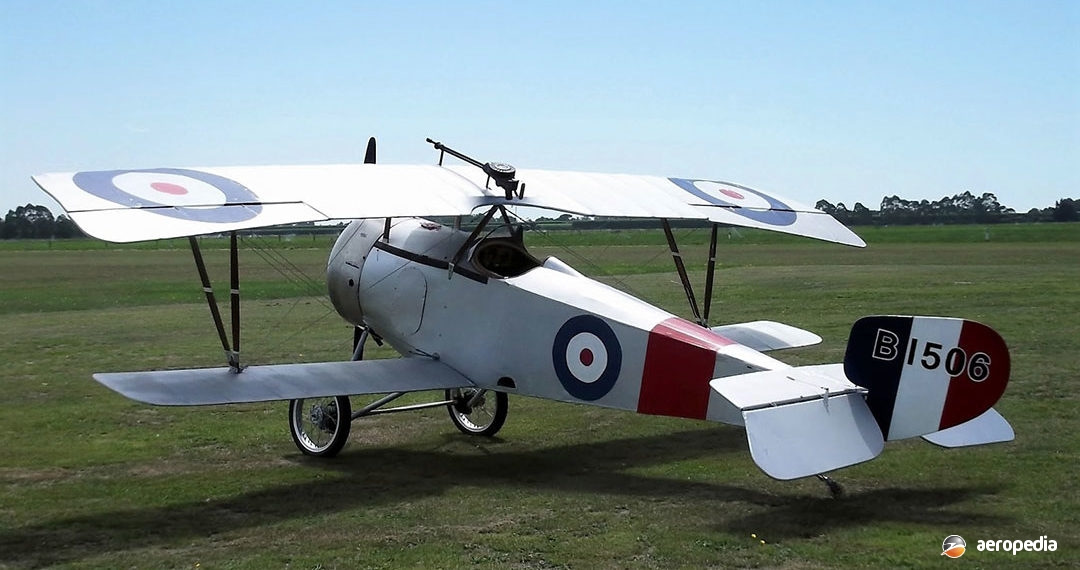Photograph:
Circa Reproductions Nieuport 11 ZK-NIE (c/n PM7668) in the markings carried by a Nieuport 17 in World War I (NZCIVAIR)
Country of origin:
Canada
Description:
Single-seat light sport biplane
Power Plant:
One 37 kw (50 hp) Rotax 503 two-cylinder, two-stroke, air-cooled engine
Specifications:
- Wingspan (upper): 6.55 m (21 ft 6 in)
- Length: 4.88 m (16 ft)
- Wing area: 10.6 m² (114 sq ft)
- Max speed: 134 km/h (83 mph)
- Cruising speed: 105 km/h (65 mph)
- Stalling speed: 43 km/h (27 mph)
- Service ceiling: 4,572 m (15,000 ft)
- Rate of climb: 229 m/min (750 ft/min)
- Range: 266 km (165 miles)
- Fuel capacity: 38 litres (8.3 Imp gals)
- Empty weight: 120 kg (265 lb)
- Loaded weight: 249 kg (550 lb)
History:
Circa Reproductions of Surrey, British Colombia in Canada was a Company which produces plans to build 87 per ent scale World War I aircraft, the aircraft design being produced by Graham Lee of Lamont, Alberta. Leading Edge Air Foils, based at Peyton in Colorado, USA, for a time provided construction kits for the designs. Main design has been the scale replica of the Nieuport 11, of which more than 400 have been produced around the world. Other designs have also been available but all are similar in looks and construction, with minor changes to make them look like scale replicas of the original aircraft. These designs have included the Nieuport 12, the Morane Saulnier N or Bullet, the Sopwith Tabloid and the Sopwith Baby.
During World War I the Nieuport 11 was built, with some minor changes, by Siemens Schuckert in Germany as the Model D.1b and an example in New Zealand has been registered as such.
The Nieuport 11 was the first of the designs and was constructed from 6061-T6 aluminium tubing, with 2024-T3 aluminium gussets, held together by blind rivets. For a period welded steel tube fuselages were also available. The wings, tail and fuselage were covered with fabric. Main wheels were 61 cm (24 in) diameter spoked units with a bungee suspension and a tailwheel was usually installed in place of a skid. Engines recommended were the 30 kw (40 hp) Rotax 447, the Rotax 503, various conversions of the four-cylinder Volkswagen, and the Hirth.
The first Nieuport 11 replica was flown in July 1984 and undertook a short test program before being shown at the Experimental Aircraft Association convention at Oshkosh in Wisconsin that year. Kits became available to meet US ultralight regulations and Experimental amateur-built regulations. In the ultralight variant lighter materials were used to save weight.
A small number of examples have been completed in this region, one becoming ZK-WWI (c/n 234), described as a Circa Reproductions Nieuport 11 but finished and painted as a Siemens Schuckert D.1b. Another was completed by Mr N B Forester of Dunedin and this aircraft, described as a Nieuport 11, became ZK-NVR (c/n 1548) on 22 January 2015. A third example was built by John Lowther of Timaru and initially painted in the markings of French ace Charles Eugene Nungessar. It was registered in March 1992 but the registration was revoked on 2 August 1999. It was offered for sale in March 2010 and was later restored by The Heritage and Sport Aviation Group of North Otago, being painted as B1506, a Nieuport 17 which had been flown by Lt Archibald Miller DFC of No 29 Squadron Royal Flying Corps.

